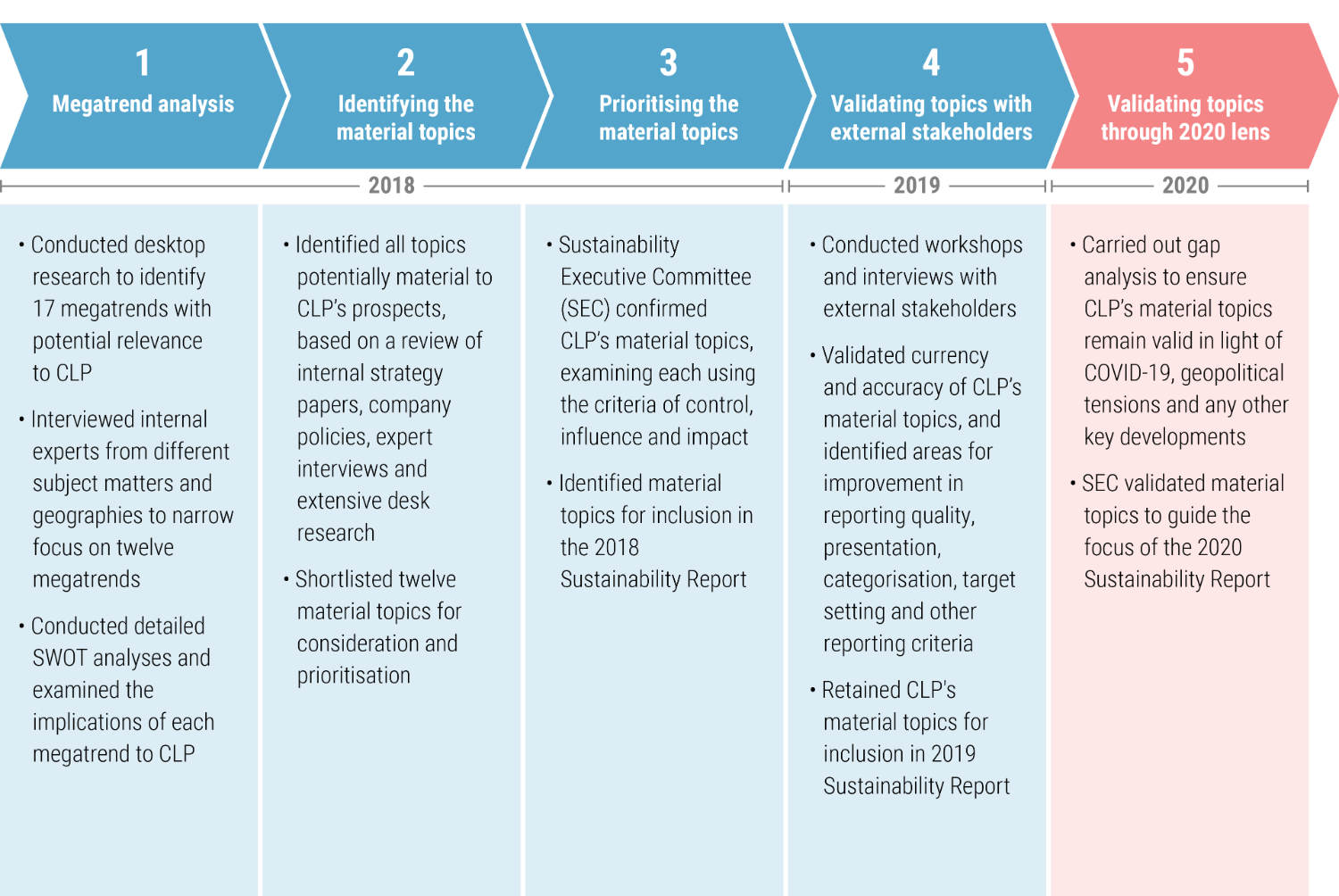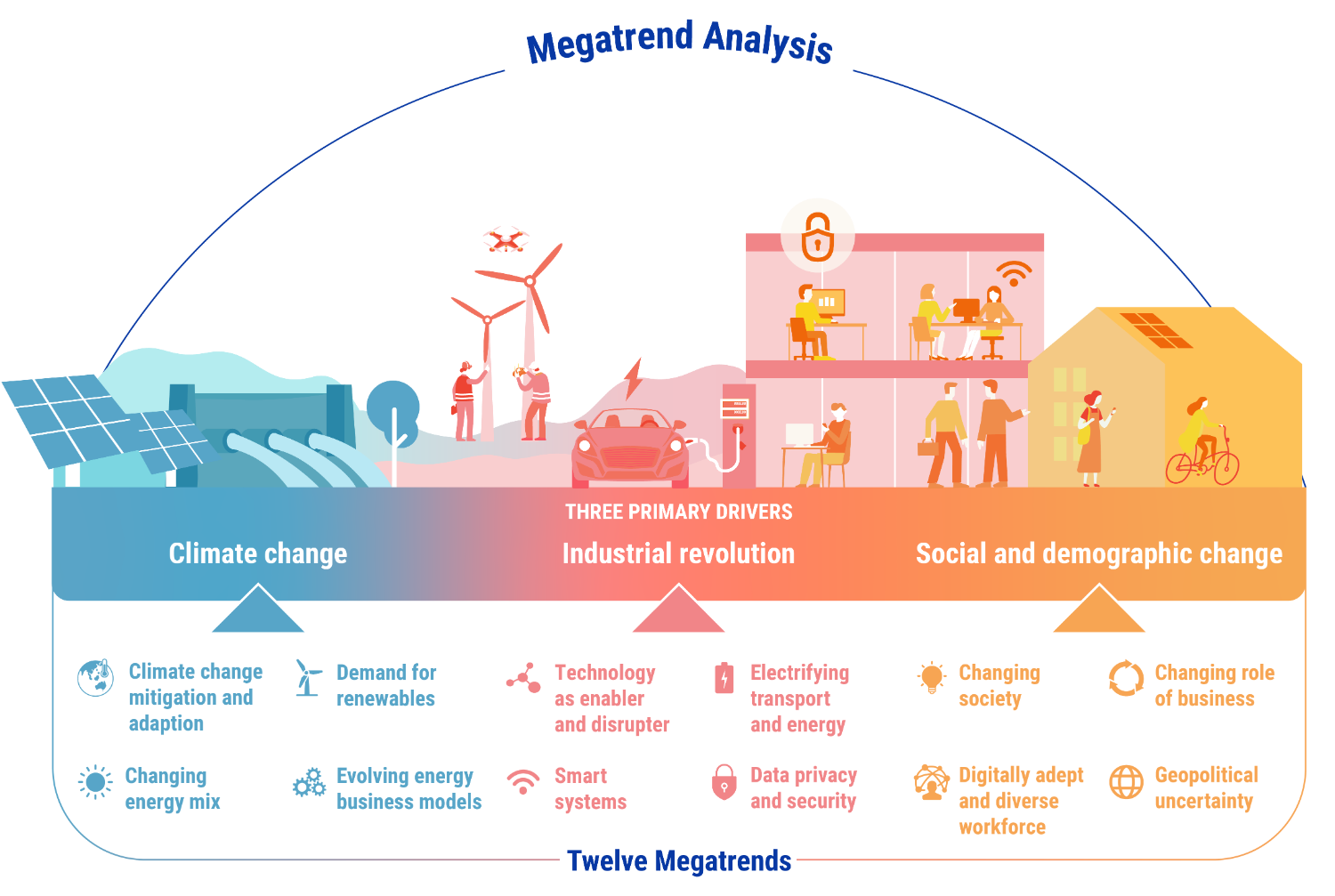The material sustainability topics identified by the Group in 2018 were expected to be valid in the medium- to long-term. Given the unprecedented turbulences in 2020, the earlier results warranted a review to understand if and how CLP‘s underlying strategic objectives have been affected.
GRI reference: 102-44, 102-46
CLP's materiality assessment was updated in 2018 to consider the operating environment and the Group's strategy in the medium- to long-term. Building on that result, engagement with external stakeholders was broadened in 2019 to validate the results and to gauge feedback on the level and quality of disclosure.
The tumultuous events of 2020 have emphasised the importance for management teams to not only identify business risks and opportunities, but also to understand how these risks and opportunities might interplay in unexpected ways. As a result, companies around the world need to retest the currency of their strategic priorities to ensure that shareholders and other stakeholders remain confident in their agility, adaptability and resilience in the face of change. The review process is outlined in the diagram below:

In 2020, an internal review assessed whether the material topics identified continue to be valid and to evaluate the impacts of the external environment on the Company. While CLP‘s strategic priorities and the material topics had not changed, the urgency to tackle these challenges had accelerated. Moreover, the importance of good corporate governance was recognised. Guided by the CLP Value Framework, governance at CLP has provided clear direction and a solid foundation to respond promptly to the challenges arising from COVID-19.
Read more about CLP‘s materiality assessment process
The relative importance of each material topic to different parts of the Company’s value chain is schematically represented below, showcasing the linkages to CLP’s business model.

The table below further explains why the topic is material and outlines key concerns in the CLP context. Further discussions are included in the relevant sections in this report.
Material topic | Why this is material | Key concerns in the CLP context |
|---|---|---|
Climate change is unquestionably the biggest issue CLP is facing. The electric utility industry offers great opportunity to slow down climate change by coupling electrification and decarbonisation. For instance, the IEA WEO 2020 Sustainable Development Scenario (SDS) projects that the share of coal in the generation mix falls rapidly from 37% in 2019 to 5% in 2040. Renewable energy is projected to displace fossil fuel generation assets, and its share in global electricity generation grows from 27% to 72% over this same period. |
| |
Digital technologies including artificial intelligence, the Internet of Things (IoT) and big data offer energy companies new ways of enhancing performance and serving customer needs. As more renewable energy is introduced into the electricity system, its intermittent nature could pose challenges to system stability and reliability. Digital platforms offer a solution by balancing dynamic customer demand against different generation profiles to optimise cost efficiency, reliability and environmental performance. |
| |
CLP's operations are becoming underpinned by digital solutions, with more information stored in cyber space. This makes the organisation more vulnerable to cyber attacks. Effective cyber defence becomes fundamental to protect the business. The Group is expected to detect and respond to any incident promptly, and have the ability to maintain normal operations and minimise inconvenience to its customers. |
| |
Digitalisation and decarbonisation of the energy sector, together with intensifying demographic and labour supply issues and social and political uncertainties, present significant workforce opportunities and challenges. CLP must ensure business continuity through: managing generational knowledge transfer; attracting and retaining the new skills, talents and mindsets of a more diverse workforce; building greater organisational agility; and meeting higher social expectations as a responsible employer. |
|
Ensuring continuity and validity of the
materiality assessment results Copy linkCopied link
The CLP materiality assessment process is guided by the Applying enterprise risk management to environmental, social and governance-related risks guidelines published by the Committee of Sponsoring Organizations of the Treadway Commission (COSO) and the World Business Council for Sustainable Development (WBCSD) in October 2018.
CLP's materiality assessment was updated in 2018 to consider the operating environment and the Group's strategy in the medium- to long-term. The validity of the results was confirmed in 2019 through external stakeholder engagement, and further reviewed in 2020 to closely consider the immediate challenges arising from COVID-19, geopolitics and other developments that unfolded throughout the year.
The process is summarised in the diagram below, with further details outlined in the following sections.

In 2018, the assessment began with a horizon scanning exercise, to deepen CLP's understanding of how broad changes in the environment, society, technology and governance were affecting its operating environment. This big picture approach provided the necessary context to review environmental, social and governance (ESG) risks and opportunities and prioritise the topics that CLP should be managing and reporting.
Megatrends are large, transformative global forces that define the future by having a far-reaching impact on business, economies, industries, societies and individuals. A megatrend is distinguished from other trends in that it cannot be stopped or significantly altered, even by powerful actors such as governments.
Seventeen megatrends were identified as potentially relevant to CLP. Internal subject matter experts from across the Company were then interviewed to gauge how these megatrends impact CLP. The views of stakeholders from outside the organisation were also considered to help identify gaps between internal and external perceptions.
Based on this process, the initial list of 17 was rationalised into 12 megatrends. Recurrent themes allowed the 12 megatrends to be grouped under three primary drivers: Climate change, Industrial Revolution 4.0 and Social and Demographic change. Each driver aligns closely with CLP’s strategic priorities.

Initially, 60 topics were identified as potentially material. These topics emerged from a comprehensive review of internal strategy papers, CLP policies, interview findings and extensive desktop research.
These topics were then grouped under the 12 megatrends and summarised using a simple phrase to facilitate discussion. Twelve material topics were then selected for further consideration. From these 12 topics, five material topics were chosen for inclusion in CLP's 2018 Sustainability Report. In evaluating the topics presented, three dimensions were considered:
Control – How much control does CLP have over the management of this topic?
Influence – How likely is this topic to influence the decisions and actions of CLP’s stakeholders?
Impact – What is the impact of this topic on people, the environment and/or the economy in CLP’s markets?
Focus group workshops and interviews were conducted with subject matter experts. The experts were selected for their knowledge in ESG reporting, finance and investment, industry, climate change, digital transformation, human rights, gender and sustainability.
Participants were probed on their views of the validity and accuracy of CLP’s five material topics and asked to identify areas for improvement in reporting quality, presentation, categorisation, target-setting and other reporting criteria. Part of the engagement was focused on understanding the needs and expectations of investors.
CLP accepted stakeholders’ suggestions to:
Reframe the 2018 material topic ‘increased expectations of business purpose’ as an overarching concept rather than a standalone topic, and
Retain all the material topics which support the overarching strategic ambitions of decarbonisation, digitalisation and workforce transformation.
This approach was continued in this 2020 report with CLP focusing on four material topics, where the level of reporting on each topic is reviewed each year to address stakeholders' concerns.
The review exercise included in-depth interviews with CLP senior executives and extensive desktop research based on internal documents, CLP policies and industry publications. Based on these findings, the Sustainability Executive Committee (SEC) considered each of the material topics in turn and confirmed that the topics remained valid. The Committee also agreed on the content under each topic, which guided the development of the Material Topics section of this report.


